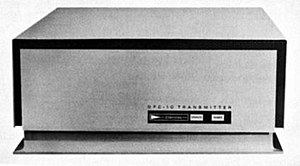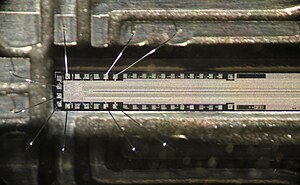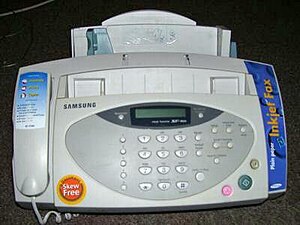Faximail
Fax


Fax (short for facsimile), sometimes calledtelecopying or telefax (the latter short fortelefacsimile), is the telephonic transmission of scanned printed material (both text and images), normally to a telephone number connected to a printer or other output device. The original document is scanned with a fax machine (or a telecopier), which processes the contents (text or images) as a single fixed graphic image, converting it into a bitmap, and then transmitting it through the telephone system in the form of audio-frequency tones. The receiving fax machine interprets the tones and reconstructs the image, printing a paper copy.[1] Early systems used direct conversions of image darkness to audio tone in a continuous or analog manner. Since the 1980s, most machines modulate the transmitted audio frequencies using a digital representation of the page which is compressed to quickly transmit areas which are all-white or all-black.
There are several indicators of fax capabilities: group, class, data transmission rate, and conformance with ITU-T (formerlyCCITT) recommendations. Since the 1968Carterphone decision, most fax machines have been designed to connect to standardPSTN lines and telephone numbers.
Group
Analog
Group 1 and 2 faxes are sent in the same manner as a frame of analog television, with each scanned line transmitted as a continuous analog signal. Horizontal resolution depended upon the quality of the scanner, transmission line, and the printer. Analog fax machines are obsolete and no longer manufactured. ITU-T Recommendations T.2 and T.3 were withdrawn as obsolete in July 1996.
- Group 1 faxes conform to the ITU-T Recommendation T.2. Group 1 faxes take six minutes to transmit a single page, with a vertical resolution of 96 scan lines per inch. Group 1 fax machines are obsolete and no longer manufactured.
- Group 2 faxes conform to the ITU-T Recommendations T.30 and T.3. Group 2 faxes take three minutes to transmit a single page, with a vertical resolution of 96 scan lines per inch. Group 2 fax machines are almost obsolete, and are no longer manufactured. Group 2 fax machines can interoperate with Group 3 fax machines.
Digital

The Dacom DFC-10—the first digital fax machine.[10]

The chip in a fax machine. Only about one quarter of the length is shown. The thin line in the middle consists of photosensitive pixels. The read-out circuit is at left.
A major breakthrough in the development of the modern facsimile system was the result of digital technology, where the analog signal from scanners was digitized and then compressed, resulting in the ability to transmit high rates of data across standard phone lines. The first digital fax machine was the Dacom Rapidfax first sold in late 1960s, which incorporated digital data compression technology developed by Lockheed for transmission of images from satellites.[10][11]
Group 3 and 4 faxes are digital formats, and take advantage of digital compression methods to greatly reduce transmission times.
- Group 3 faxes conform to the ITU-T Recommendations T.30 and T.4. Group 3 faxes take between six and fifteen seconds to transmit a single page (not including the initial time for the fax machines to handshake and synchronize). The horizontal and vertical resolutions are allowed by the T.4 standard to vary among a set of fixed resolutions:
- Horizontal: 100 scan lines per inch
- Vertical: 100 scan lines per inch ("Basic")
- Horizontal: 200 or 204 scan lines per inch
- Vertical: 100 or 98 scan lines per inch ("Standard")
- Vertical: 200 or 196 scan lines per inch ("Fine")
- Vertical: 400 or 391 (note not 392) scan lines per inch ("Superfine")
- Horizontal: 300 scan lines per inch
- Vertical: 300 scan lines per inch
- Horizontal: 400 or 408 scan lines per inch
- Vertical: 400 or 391 scan lines per inch ("Ultrafine")
- Horizontal: 100 scan lines per inch
- Group 4 faxes conform to the ITU-T Recommendations T.563, T.503, T.521, T.6, T.62, T.70, T.411 to T.417. They are designed to operate over 64 kbit/s digital ISDN circuits. The allowed resolutions, a superset of those in the T.4 recommendation, are specified in the T.6 recommendation.[19]
Fax Over IP (FoIP) can transmit and receive pre-digitized documents at near realtime speeds using ITU-T recommendation T.38 to send digitised images over an IP networkusing JPEG compression. T.38 is designed to work with VoIP services and often supported by analog telephone adapters used by legacy fax machines that need to connect through a VoIP service. Scanned documents are limited to the amount of time the user takes to load the document in a scanner and for the device to process a digital file. The resolution can vary from as little as 150 DPI to 9600 DPI or more. This type of faxing is not related to the e-mail to fax service that still uses fax modems at least one way.
Class
Computer modems are often designated by a particular fax class, which indicates how much processing is offloaded from the computer's CPU to the fax modem.
- Class 1 fax devices do fax data transfer where the T.4/T.6 data compression and T.30 session management are performed by software on a controlling computer. This is described in ITU-T recommendation T.31.[20]
- Class 2 fax devices perform T.30 session management themselves, but the T.4/T.6 data compression is performed by software on a controlling computer. The relevant ITU-T recommendation is T.32.[20]
- Class 2.0 is different from Class 2.
- Class 2.1 is an improvement of Class 2.0. Class 2.1 fax devices are referred to as "super G3"; they seem to be a little faster than Class 1/2/2.0.
- Class 3 fax devices are responsible for virtually the entire fax session, given little more than a phone number and the text to send (including rendering ASCII text as a raster image). These devices are not common.
Data transmission rate
Several different telephone line modulation techniques are used by fax machines. They are negotiated during the fax-modemhandshake, and the fax devices will use the highest data rate that both fax devices support, usually a minimum of 14.4 kbit/s for Group 3 fax.
Note that "Super Group 3" faxes use V.34bis modulation that allows a data rate of up to 33.6 kbit/s.
Compression
As well as specifying the resolution (and allowable physical size of the image being faxed), the ITU-T T.4 recommendation specifies two compression methods for decreasing the amount of data that needs to be transmitted between the fax machines to transfer the image. The two methods defined in T.4 are:[21]
- Modified Huffman (MH), and
- Modified READ (MR) (Relative Element Address Designate[22]), optional
An additional method is specified in T.6:[19]
- Modified Modified READ (MMR)
Later, other compression techniques were added as options to ITU-T recommendation T.30, such as the more efficient JBIG (T.82, T.85) for bi-level content, and JPEG (T.81), T.43, MRC (T.44), and T.45 for grayscale, palette, and colour content.[23] Fax machines can negotiate at the start of the T.30 session to use the best technique implemented on both sides.
Modified Huffman
Modified Huffman (MH), specified in T.4 as the one-dimensional coding scheme, is a codebook-based run-length encoding scheme optimised to efficiently compress whitespace.[21] As most faxes consist mostly of white space, this minimises the transmission time of most faxes. Each line scanned is compressed independently of its predecessor and successor.[21]
Modified READ
Modified READ (MR), specified as an optional two-dimensional coding scheme in T.4, encodes the first scanned line using MH.[21]The next line is compared to the first, the differences determined, and then the differences are encoded and transmitted.[21]This is effective as most lines differ little from their predecessor. This is not continued to the end of the fax transmission, but only for a limited number of lines until the process is reset and a new 'first line' encoded with MH is produced. This limited number of lines is to prevent errors propagating throughout the whole fax, as the standard does not provide for error-correction. MR is an optional facility, and some fax machines do not use MR in order to minimise the amount of computation required by the machine. The limited number of lines is two for 'Standard' resolution faxes, and four for 'Fine' resolution faxes.
Modified Modified READ
The ITU-T T.6 recommendation adds a further compression type of Modified Modified READ (MMR), which simply allows for a greater number of lines to be coded by MR than in T.4.[19] This is because T.6 makes the assumption that the transmission is over a circuit with a low number of line errors such as digital ISDN. In this case, there is no maximum number of lines for which the differences are encoded.
JBIG
In 1999, ITU-T recommendation T.30 addedJBIG (ITU-T T.82) as another lossless bi-levelcompression algorithm, or more precisely a "fax profile" subset of JBIG (ITU-T T.85). JBIG-compressed pages result in 20% to 50% faster transmission than MMR-compressed pages, and up to 30-times faster transmission if the page includes halftone images.
JBIG performs adaptive compression, that is both the encoder and decoder collect statistical information about the transmitted image from the pixels transmitted so far, in order to predict the probability for each next pixel being either black or white. For each new pixel, JBIG looks at ten nearby, previously transmitted pixels. It counts, how often in the past the next pixel has been black or white in the same neighborhood, and estimates from that the probability distribution of the next pixel. This is fed into an arithmetic coder, which adds only a small fraction of a bit to the output sequence if the more probable pixel is then encountered.
The ITU-T T.85 "fax profile" constrains some optional features of the full JBIG standard, such that codecs do not have to keep data about more than the last three pixel rows of an image in memory at any time. This allows the streaming of "endless" images, where the height of the image may not be known until the last row is transmitted.
ITU-T T.30 allows fax machines to negotiate one of two options of the T.85 "fax profile":
- In "basic mode", the JBIG encoder must split the image into horizontal stripes of 128 lines (parameter L0=128), and restart the arithmetic encoder for each stripe.
- In "option mode", there is no such constraint.
Matsushita Whiteline Skip
A proprietary compression scheme employed on Panasonic fax machines is Matsushita Whiteline Skip (MWS). It can be overlaid on the other compression schemes, but is operative only when two Panasonic machines are communicating with one another. This system detects the blank scanned areas between lines of text, and then compresses several blank scan lines into the data space of a single character. (JBIG implements a similar technique called "typical prediction", if header flag TPBON is set to 1.)
Typical characteristics
Group 3 fax machines transfer one or a few printed or handwritten pages per minute in black-and-white (bitonal) at a resolution of 204×98 (normal) or 204×196 (fine) dots per square inch. The transfer rate is 14.4 kbit/s or higher for modems and some fax machines, but fax machines support speeds beginning with 2400 bit/s and typically operate at 9600 bit/s. The transferred image formats are called ITU-T (formerly CCITT) fax group 3 or 4. Group 3 faxes have the suffix
.g3 and theMIME type image/g3fax.
The most basic fax mode transfers in black and white only. The original page is scanned in a resolution of 1728 pixels/line and 1145 lines/page (for A4). The resulting raw data iscompressed using a modified Huffman codeoptimized for written text, achieving average compression factors of around 20. Typically a page needs 10 s for transmission, instead of about 3 minutes for the same uncompressed raw data of 1728×1145 bits at a speed of 9600 bit/s. The compression method uses a Huffman codebook for run lengths of black and white runs in a single scanned line, and it can also use the fact that two adjacent scanlines are usually quite similar, saving bandwidth by encoding only the differences.
Fax classes denote the way fax programs interact with fax hardware. Available classes include Class 1, Class 2, Class 2.0 and 2.1, and Intel CAS. Many modems support at least class 1 and often either Class 2 or Class 2.0. Which is preferable to use depends on factors such as hardware, software, modem firmware, and expected use.
Printing process
Fax machines from the 1970s to the 1990s often used direct thermal printers with rolls of thermal paper as their printing technology, but since the mid-1990s there has been a transition towards plain-paper faxes:- thermal transfer printers, inkjet printers and laser printers.
One of the advantages of inkjet printing is that inkjets can affordably print in color; therefore, many of the inkjet-based fax machines claim to have color fax capability. There is a standard called ITU-T30e (formally ITU-T Recommendation T.30 Annex E [24]) for faxing in color; unfortunately, it is not widely supported, so many of the color fax machines can only fax in color to machines from the same manufacturer.
Stroke speed
Stroke speed in facsimile systems is the rate at which a fixed line perpendicular to the direction of scanning is crossed in one direction by a scanning or recording spot. Stroke speed is usually expressed as a number of strokes per minute. When the fax system scans in both directions, the stroke speed is twice this number. In most conventional 20th century mechanical systems, the stroke speed is equivalent to drum speed.[25]
Fax paper
As a precaution, thermal fax paper is typically not accepted in archives or as documentary evidence in some courts of law unless photocopied. This is because the image-forming coating is eradicable and brittle, and it tends to detach from the medium after a long time in storage.[26]



Comments
Post a Comment